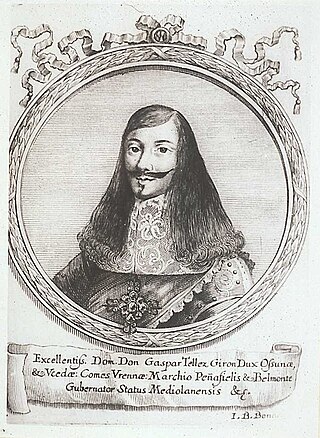Related Research Articles

Duke of Osuna is a Spanish noble title that was first awarded in 1562 by King Philip II of Spain to Pedro Girón de la Cueva,. Pedro was also Viceroy of Naples, (1582–1586), Ambassador in Portugal and 5th Count of Ureña.

Pedro de Alcántara Téllez-Girón y Pacheco, 9th Duke of Osuna, Grandee of Spain, was a Spanish nobleman and military commander during the French Revolutionary Wars.

Lady María Josefa de Borja Pimentel y Téllez-Giróniure uxorisDuchess of Osuna, suo jure12th Duchess of Benavente, was a Spanish Salonnière, famous as a patron of artists, writers and scientists and an important figure of the Spanish Age of Enlightenment. She was the first female (honorary) member of the royal Sociedad Económica de Amigos del País de Madrid as well as the first president of the royal Junta de Damas de Honor y Mérito.

Doña Joaquina Téllez-Girón y Pimentel, 2nd Countess of Osilo, iure uxorisMarchioness of Santa Cruz was a daughter of Pedro Téllez-Girón, 9th Duke of Osuna and María Josefa Pimentel, 12th Countess-Duchess of Benavente.

Gaspar Téllez-Girón, 5th Duke de Osuna, 5th Marquess of Peñafiel, 9th Count of Ureña and other lesser titles, was a Spanish general and a Grandee of Spain.

Duke of Gandía is a title of Spanish nobility that was first created in 1399 by Martin of Aragon and granted to Alfonso of Aragon and Foix. It has its origin in the lordship of Gandía created in 1323 by James II of Aragon. Later, having no direct descendants, the title passed from the House of Barcelona to the House of Trastámara.

Francisco de Borja Téllez-Girón y Pimentel, 10th Duke de Osuna, Grandee of Spain, , was a Spanish nobleman.
The Sicilian title Duke of Bivona stems from the middle 16th century. Bivona is in Sicily, which had been conquered by Peter III of Aragon in 1282. It was given to people related to the powerful medieval Aragonese family of Luna, Zaragoza.

Diego Enríquez de Guzmán, 5th count of Alba de Liste, Viceroy of Sicily (1585–1591), a Knight of the Order of the Golden Fleece since the year 1600, was the son of Enrique Enriquez, 4th count of Alba de Liste, and Maria Alvarez de Toledo y Pimentel, one daughter of Garcia Alvarez de Toledo, 2nd duke of Alba and of Beatriz Pimentel, a daughter of the 4th count and 1st duke of Benavente since January 1473, Rodrigo Alfonso Pimentel.

Duke of Plasencia is a hereditary title in the Spanish nobility. It was granted on 1476 by Queen Isabella I and King Ferdinand V of Castile, The Catholic Monarchs, to Álvaro de Zúñiga y Guzmán, 2nd count of Plasencia and also 1st Duke of Béjar, 1st Duke of Arévalo and 1st Count of Bañares, in acknowledgment for his loyalty during the War of Castilian Succession.

Marquess of Villena is a hereditary title in the Peerage of Spain, granted in 1445 by John II to Juan Pacheco, Grand Master of the Order of Santiago and later also 1st Duke of Escalona.

Pedro de Alcántara Téllez-Girón y Beaufort Spontin, 11th Duke of Osuna, GE, was a Spanish peer, head of the House of Osuna. He was one of the most important peers of his time, and was thirteen times a duke, twelve a marquess, thirteen a count and once a viscount.

Duke of Benavente is a hereditary title in the Peerage of Spain, accompanied by the dignity of Grandee and granted in 1473 by Henry IV to Rodrigo Alonso Pimentel, 4th Count of Benavente.

Prince of Squillace was a noble title created in 1494, by King Alfonso II of Naples for Gioffre Borgia on the occasion of his wedding with the king's daughter Sancia d'Aragona. He was also created Count of Cariati. His second wife was María de Mila y Aragón with whom he had issue. The male line became extinct after the death of the fourth title-holder, Pietro Borgia d'Aragona, the last male heir to hold this title.

Count of Mayalde is a noble title created in 1596 by King Philip II of Spain for Juan de Borja y Castro son of Saint Francis Borgia, 1st Marquis of Lombay.

José Gabriel de Silva-Bazán y Waldstein, 10th Marquess of Santa Cruz de Mudela, was a Spanish noble, first director of the Prado Museum between 1817 and 1820 and Mayordomo mayor between 1822 and 1823.
Ángela María Téllez-Girón y Duque de Estrada, 16th Duchess of Osuna, GE (1925–2015) was a Spanish noblewoman. She was a holder of ten grandeeships of Spain.

Count of Villaverde de Madrid, commonly known as Count of Villaverde is a hereditary title in the Peerage of Spain, granted in 1602 by Philip III to Lope de Guzmán y Portocarrero.

The Duke and Duchess of Osuna and their Children is a family group painting by the Spanish painter Francisco Goya.
References
- ↑ Soler Salcedo 2008, p. 403.
- ↑ Batllori 1999, pp. 71–72.
- ↑ St. Francis Borgia, biography, [
- ↑ Soler Salcedo 2008, pp. 221–222.
- ↑ Soler Salcedo 2008, p. 224.
- ↑ Soler Salcedo 2008, pp. 224–225.
- ↑ Soler Salcedo 2008, p. 225.
- ↑ Soler Salcedo 2008, pp. 225–226.
- ↑ Soler Salcedo 2008, p. 226.
- ↑ Soler Salcedo 2008, p. 228.
- ↑ Soler Salcedo 2008, pp. 227–228.
- ↑ Salazar y Acha 2010, p. 17.
- ↑ Soler Salcedo 2008, pp. 228–229.
- 1 2 Soler Salcedo 2008, pp. 229–230.
- ↑ Soler Salcedo 2008, p. 121.
- ↑ Soler Salcedo 2008, pp. 30, 121.
- ↑ "Order JUS/419/2016 of 17 March" (PDF). BOE. Spanish Official State Gazette. 17 March 2016. Retrieved 7 April 2016.